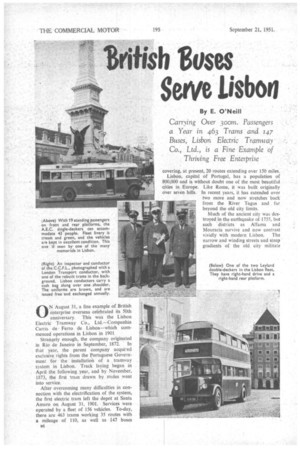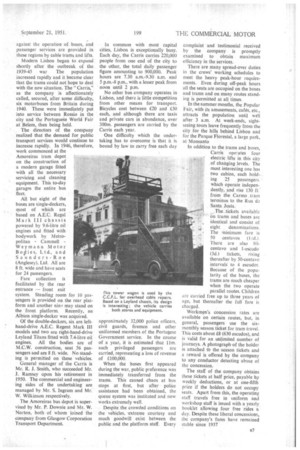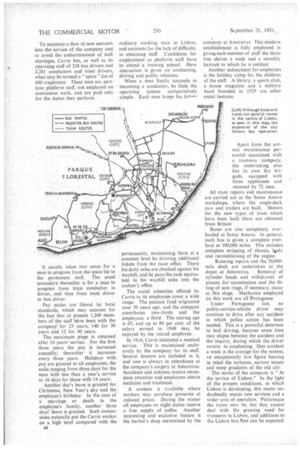'British Buses Serve Lisbon
Page 40

Page 41

Page 42

If you've noticed an error in this article please click here to report it so we can fix it.
By E. O'Neill
Carrying Over 30om. Passengers a Year in 463 Trams and 147 Buses, Lisbon Electric Tramway Co., Ltd., is a Fine Example of
Thriving Free Enterprise
0 N August 31, a fine example of British enterprise overseas celebrated its 50th anniversary. This was the Lisbon Electric Tramway Co., Ltd.—Companhia Carti. de Ferro de Lisboa—which commenced operations in Lisbon in 1901.
Strangely enough, the company originated
in Rio de Janeiro in September, 1872. In that year, the parent company acquiTed exclusive rights from the Portuguese Government for the installation of a tramway system in Lisbon. Track laying began in April the following year, and by November, 1873, the first tram drawn by mules went
into service. .
After overcoming many difficulties in connection with the electrification of the system, the first electric tram left the depot at Santa Amaro on August 31, 1901. Services were operated by a fleet of 156 vehicles. To-day, there are 463 trams working 35 routes with a mileage of 110, as well as 147 buses
B6 covering, at present, 20 routes extending over ISO miles.
Lisbon, capital of Portugal, has a population of 800,000 and is without doubt one of the most beautiful cities in Europe. Like Rome, it was built originally over seven hills. In recent years, it has extended over two more and now stretches back from the River Tagus and far beyond the old city limits.
Much of the ancient city was destroyed in the earthquake of 1755, but such districts as Alfama and Mouraria survive and now contrast
vividly with modern Lisbon. The narrow and winding streets and steep gradients of the old city militate
against the operation of buses, and passenger services are provided in these regions by cable trams and lifts.
Modern Lisbon began to expand shortly after the outbreak of the 1939-45 war The population increased rapidly and it became clear that the trams could not hope to deal with the new situation. The "Carris," as the company is affectionately called, secured, after some difficulty, six motorbuses from Britain during 1940. These were immediately put into service between Rossi° in the city and the Portuguese World Fair at Belem, then being held.
The directors of the company realized that the demand for public transport services would continue to increase rapidly. In 1946, therefore, work commenced at the Amoreiras tram depot on the construction of a modern garage fitted with all the necessary servicing and cleaning equipment. This to-day garages the entire bus fleet.
All but eight of the buses are single-deckers, most of which are based on A.E.C. Regal Mark III chassis powered by 9.6-litre oil engines and fitted with bodywork by Metropolitan Cammell Weymann Motor Bodies, Ltd., and Saunders-Roe (Anglesey), Ltd. All are 8 ft. wide and have seats for 24 passengers.
Fare collection is facilitated by the rear entrance — front exit system. Standing room for 10 passengers is provided on the rear platform and another ttin may stand on the front platform. Recently, an Albion single-decker was acquired.
Of the double-deckers, six are lefthand-drive A.E.C. Regent Mark III models and two are right-hand-drive Leyland Titans fitted with 7.4-litre oil engines. All the bodies are of M.C.W. construction, seat 56 passengers and are 8 ft. wide. No standing is permitted on these vehicles.
General manager of the Carris is Mr. R. J. Smith, who succeeded Mr. J. Ramsey upon his retirement in 1950. The commercial and engineering sides of the undertaking are managed by Mr. S. Ingram and Mr. W. Wilkinson respectively.
The Amoreiras bus depot is supervised by Mr. P. Downie and Mr. W. Norton, both of whom joined the company from Glasgow Corporation Transport Department. In common with most capital cities, Lisbon is exceptionally busy. Each day, the Carris carries 220,000 people from one end of the city to the other, the total daily passenger figure amounting to 900,000. Peak hours are 7.30 a.m.-9.30 a.m. and 5 p.m.-8 p.m., with a lesser peak from noon until 2 p.m.
No other bus company operates in Lisbon, and there is little competition from other means for transport. Bicycles cost between £20 and £30 each, and although there are taxis and private cars in abundance, over 300m. passengers are carried by the Carris each year.
One difficulty which the undertaking has to overcome is that it is bound by law to carry free each day
approximately 32,000 police officers,
civil guards, firemen and other uniformed members of the Portugese Government service. In the course of a year, it is estimated that Urn. such privileged passengers are carried, representing a loss of revenue of £100,000.
When the buses first appeared during the war, public preference was immediately transferred from the trams. This caused chaos at bus stops at first, but after police assistance had been obtained, the queue system was instituted and now works extremely well.
Despite the crowded conditions on the vehicles, 'extreme courtesy and much goodwill exist between the public and the platform staff. Every complaint and testimonial received by the company is promptly examined to obtain maximum efficiency in the services.
There are many spread-over duties in the crews' working schedules to meet the heavy peak-hour requirements. Even during off-peak hours all the seats are occupied on the buses and trams and on many routes standing is permitted at all times,
In the summer months, the Popular Fair, with its amusements, cafés, etc., attracts the population until well after 3 a.m. At week-ends, sightseeing tours leave frequently from the city for the hills behind Lisbon and for the Parque Florestal, a large park, at Monsanto
En addition to the trams and buses, Carris opwates four electric lifts in this city of changing levels. The most interesting one has two cabins, each holding 25 passengers. which operate independently, and rise 130 ft: from the Carmo ..tram terminus to the Rua d.2 Santa Justa.
The. tickets available on trams and buses are identical and consist of eight denominations: The minimum fare is 50 centavos (1.icl.). There are also 80centavo and 1-escudo (3d.) tickets, rising thereafter by 50-centavo intervals to 4 escudos. Because of the popularity of the buses, the trams are much cheaper when the two operate parallel routes. Children are carried free up to three years of age, but thereafter the full fare is charged.
Workrnpn's concession rates are available on certain routes, but, in general, passengers use the sixmonthly season ticket for tram travel. This costs about £8 (630 escudos), and is Valid for an unlimited number of journeys. A photograph .of the holder is attached to the season tickets and a reward is offered by the company to any conductor detecting abuse of the concession.
The staff of the company obtains these tickets at half price, payable by weekly deductions, or at one-fifth price if the holders do not occupy seats. Apart from this, the operating staff travels free in uniform and workshop staff is issued with a yearly booklet allowing four free rides a day. Despite these liberal concessions, the company's fares have remained stable since 1937 To maintain a flow of new entrants into the service of the company and to avoid the embarrassment of staff shortages, Carris has, as well as its operating staff of 218 bus drivers and 2,281 conductors and tram drivers, what may be termed a " spare " list of 600 employees. These men are parttime platform staff, not employed on continuous work, and are paid only for the duties they perform.
It usually takes two years for a man to progress from the spare list to the permanent staff. The usual procedure thereafter is for a man to progress from tram conductor to driver, and then from tram driver to bus driver. Pay scales are liberal by local standards, which may account for the fact that at present 1,200 members of the staff have been with the companyfor 25 years, 140 for 30 years and 12 for 40 years. The maximum page is obtained after 14 years' service. For the first three years the pay is increased annually; thereafter it increases every three years. Holidays with. pay are granted to all employees, the scale ranging from three days for the man with less than a year's service to 16 days for those with 14 years. Another day's leave is granted for Christmas, New Year's day and the employee's birthday In the case of a marriage or death in the employee's family, another three days' leave is granted. Such concessions naturally put the Carris worker on a high level compared with the 138 ordinary working man in Lisbon, and accounts for the lack of difficulty in obtaining staff. Candidates for employment as platform staff have to attend a training school. Here instruction is given on conducting, driving and public relations. When a man finally succeeds in becoming a conductor, he finds the operating system comparatively simple. Each man keeps his tiek,.r.
permanently, maintaining them at a constant level by drawing additional tickets from the issue office. There his daily sales are checked against his waybill, and he pays the cash equivalent to his waybill sales into the cashier's office. The social amenities offered by Carris to its employees cover a wide range. The pension fund originated over 30 years ago, and the company contributes two-thirds and the employees a third. The retiring age is 65, and up to 80 per cent, of the salary earned in 1948 may be enjoyed by the retired employee. In 19.14, Carris instituted a medical service. This is maintained exclusively by the company for its staff. Several doctors are included in it, and one is always in attendance at the company's surgery at Amoreiras. Accidents and sickness receive immediate attention and employees obtain medicine and treatment. A canteen is available where workers may purchase groceries at reduced prices. During the winter all employees on night duties receive a free supply of coffee. Another interesting and. exclusive feature is the barber's shop maintained by the company at Amoreiras This modern establishment is fully employed in giving each member of staff the three free shaves a week and a monthly haircuit to which he is entitled. Another inducement for employees is the holiday camp for the children of the staff. A library, a sports club, a house magazine and a military band founded in 1929 are other social features.
Apart from the normal maintenance personnel associated with a tramway company, the undertaking also has its own fire brigade, equipped with three appliances and manned by 72 men. All tram repairs and maintenance are carried out at the Santo Amaro workshops, where the single-deck cars and trailers are built. Motors for the new types of tram which have been built there are obtained from Britain Buses are also completely overhauled at Santo Amaro. In general, each bus is given a complete overhaul at 100,000 miles. This includes complete stripping of chassis, WO and reconditioning of the engine. Running repairs and the 50,000mile dock are undertaken at the depot at Amoreiras. Removal of cylinder heads and withdrawal of pistons for -examination and the fitting of new rings, if necessary, occur at this stage. Mechanics emplOyed on this work are all Portuguese. Under Portuguese law, no public-service-vehicle driver may continue to drive after any accident in which police action has been needed. This is a powerful deterrent to bad driving, because some time may elapse between the accident and the inquiry, during which the driver reverts to conducting. One accident a week is the average for the system, an exceptionally low figure bearing in mind the tortuous, narrow streets and steep gradients of the old city. The motto of the company is " At the service of Lisbon." In the light of the present conditions, in which Lisbon is developing, this motto undoubtedly means new services and a wider area of operation. Picturesque the trams may be. but they cannot deal with the growing need for transport in Lisbon, and additions to the Lisbon bus fleet can be expected.




























































































